Ants are among most prevalent pests in structures. They regularly infest schools, restaurants, hospitals, offices, warehouses, and other buildings where they find food and water. Most ants can bite with their pincer like jaws. They are annoying pests primarily because they appear in large numbers in buildings and may nest in wall voids or other parts of the structures. Like termites they are social insects and live in colonies.
Ants have a complete metamorphosis comprised of four stages; about four to eight weeks, or sometimes more, are required for development from eggs to adult stage. Ants live in colonies and have a well developed caste system for division of labor, Workers are all sterile females, and they care for the new eggs, larvae and pupae in each succeeding generation. Queens are generally the largest individuals in the colony. They lay eggs and participate in feeding and grooming of larvae, defend the colony. Males do not participate in colony activities.
Ants usually nest in soil; nest sites vary with species but are often found next to buildings, along the sidewalks or in close proximity to food sources. Ants that nests indoors make nest in warm, moist locations, such as inside wall or cabinet voids, under flooring or around the water pipes, behind wallboard or baseboards.
Because of the wide variation in feeding and other habits of different species, their successful management often requires identification of the species involved. Ants that invade buildings and homes include the Argentine ants, Pharoh ants, Odorous ant and several species of Carpenter ants.
1. Argentine ants (Linepithema humile)
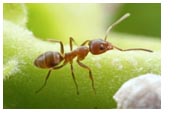 The workers are 1/8 in. long and light to dark brown in color. They have one segmented petiole and 12 segmented antennae with no hub. Workers are very aggressive and often eliminate other ants in the area. Argentine ants prefer sweet foods, sugar, syrup, honey dew. Foragers may enter houses in large numbers, particularly when the conditions outside are too wet or too dry. Nests are typically located in moist soil next to or under buildings, along sidewalks. They are usually near the sources of both water and food.
The workers are 1/8 in. long and light to dark brown in color. They have one segmented petiole and 12 segmented antennae with no hub. Workers are very aggressive and often eliminate other ants in the area. Argentine ants prefer sweet foods, sugar, syrup, honey dew. Foragers may enter houses in large numbers, particularly when the conditions outside are too wet or too dry. Nests are typically located in moist soil next to or under buildings, along sidewalks. They are usually near the sources of both water and food.
2. Carpenter ants (Camponotus spp.)
 Carpenter ants are among the most conspicuous of ants found in and around homes, being large and typically blackish or very dark bodied in color or bi-colored red and black. Foraging workers have rather large mandibles, with which they can bite. The polymorphic workers vary greatly in size from ¼ to about ¾ in. long. Foraging ants will travel 100 yds. or more from nest for food, and they may wander throughout the house, without any noticeable effect of a trail pheromone. Nest may be located in tree stumps, fire Wood, fence posts, hollow doors or window frames deposits saw dusts like frass outside nests. Wood that is moist or partially decayed, is preferred by many species. Carpenter ant’s diet includes both animal and protein foods, they will feed on other insects living or dead, sweets, aphid honeydew is particularly attractive.
Carpenter ants are among the most conspicuous of ants found in and around homes, being large and typically blackish or very dark bodied in color or bi-colored red and black. Foraging workers have rather large mandibles, with which they can bite. The polymorphic workers vary greatly in size from ¼ to about ¾ in. long. Foraging ants will travel 100 yds. or more from nest for food, and they may wander throughout the house, without any noticeable effect of a trail pheromone. Nest may be located in tree stumps, fire Wood, fence posts, hollow doors or window frames deposits saw dusts like frass outside nests. Wood that is moist or partially decayed, is preferred by many species. Carpenter ant’s diet includes both animal and protein foods, they will feed on other insects living or dead, sweets, aphid honeydew is particularly attractive.
3. Odorous house ants (Tapinoma sessile)
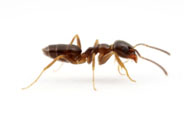 The odorous house ant is among common household pests, having about 1/8 in. long, dark brown to shiny black monomorphic workers. It can easily be distinguished with the Argentine ants by its darker color and the fact that the front of its abdomen
overhangs and hides its flattened petiole. This ant also gives a very pungent odor when crushed. Workers forage along regular trail, these ants prefers sweet foods and sometime proteins. .Odorous house ants tend to move indoors, when honeydew becomes less abundant, especially during and after heavy rain. Nest may be located in shallow mounds in soil or debris or indoors in wall voids, attics or around water pipes or heaters.
The odorous house ant is among common household pests, having about 1/8 in. long, dark brown to shiny black monomorphic workers. It can easily be distinguished with the Argentine ants by its darker color and the fact that the front of its abdomen
overhangs and hides its flattened petiole. This ant also gives a very pungent odor when crushed. Workers forage along regular trail, these ants prefers sweet foods and sometime proteins. .Odorous house ants tend to move indoors, when honeydew becomes less abundant, especially during and after heavy rain. Nest may be located in shallow mounds in soil or debris or indoors in wall voids, attics or around water pipes or heaters.
4. Velvety tree ants (Liometopum occidentale)
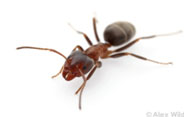 They are easily identified by their velvety- black abdomen, red thorax and brownish-black head. Foragers travel along trails. These ants tend honeydew- producing insects such as aphids, or scale insects, and also kill and eat other insects. The workers are aggressive and often invade picnic or outdoor barbecue areas, contaminating food , stinging people and spraying defensive foul odor..When they forage and nest inside homes, the homeowners will frequently complain their foul odor. Their preferred food is sweets and insects. Nest may be in dead Wood such as old tree limbs, stumps, and logs, under the bark, beneath stones on ground and occasionally within the walls and attics of homes.
They are easily identified by their velvety- black abdomen, red thorax and brownish-black head. Foragers travel along trails. These ants tend honeydew- producing insects such as aphids, or scale insects, and also kill and eat other insects. The workers are aggressive and often invade picnic or outdoor barbecue areas, contaminating food , stinging people and spraying defensive foul odor..When they forage and nest inside homes, the homeowners will frequently complain their foul odor. Their preferred food is sweets and insects. Nest may be in dead Wood such as old tree limbs, stumps, and logs, under the bark, beneath stones on ground and occasionally within the walls and attics of homes.
5. Pharoh ants (Monomorium pharaonis)
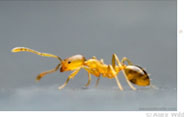 Pharoh ants are light yellowish to reddish brown in color; with monomorphic workers measuring 1/15 in. long. They are an important ant pest in homes, apartments, hospitals, hotels, restaurants and other facilities. Their small size and very wide food
preferences make them difficult to eliminate from structures. It has a tendency to appear suddenly in various places within the structure, forage over wide areas and nest in a well protected areas contribute to control difficulties. Any kind of stress can cause the colonies to split into sub-colonies, which scatter to other locations within the structure, this behavioral process is called budding. Sometimes a group of workers may be seen carrying brood (eggs, larvae and pupae).away from the larger colony to begin a new colony unit. Pharoh ant will feed on diverse materials like syrup, fruit juice, honey, jelly, greases, dead insects, meats and bloods etc. Nests are found in wall or cabinet voids, behind baseboards, or insulation or outdoors in debris.
Pharoh ants are light yellowish to reddish brown in color; with monomorphic workers measuring 1/15 in. long. They are an important ant pest in homes, apartments, hospitals, hotels, restaurants and other facilities. Their small size and very wide food
preferences make them difficult to eliminate from structures. It has a tendency to appear suddenly in various places within the structure, forage over wide areas and nest in a well protected areas contribute to control difficulties. Any kind of stress can cause the colonies to split into sub-colonies, which scatter to other locations within the structure, this behavioral process is called budding. Sometimes a group of workers may be seen carrying brood (eggs, larvae and pupae).away from the larger colony to begin a new colony unit. Pharoh ant will feed on diverse materials like syrup, fruit juice, honey, jelly, greases, dead insects, meats and bloods etc. Nests are found in wall or cabinet voids, behind baseboards, or insulation or outdoors in debris.
6. Thief ants (Solenopsis molesta)
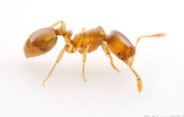 This is one of the smallest household ants being 1/25 in. long, Workers are monomorphic, and vary in color from yellow to light brown. They feature a two segmented antennal club. They often live in the nests of large ants, where they may feed on the larvae of their hosts – thereby earning their common name. Their chief foods in homes are greasy materials, such as cheese, meats and sometimes sweets. Nest is seen outdoors in soil or under rocks or decaying Wood, indoors behind wallboards and baseboards.
This is one of the smallest household ants being 1/25 in. long, Workers are monomorphic, and vary in color from yellow to light brown. They feature a two segmented antennal club. They often live in the nests of large ants, where they may feed on the larvae of their hosts – thereby earning their common name. Their chief foods in homes are greasy materials, such as cheese, meats and sometimes sweets. Nest is seen outdoors in soil or under rocks or decaying Wood, indoors behind wallboards and baseboards.
7. Pavement ants (Tetramorium caespitum)
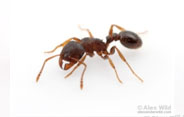 This is a small blackish brown ant. The abdomen is all black and there is a pair of small spines at the back of the thorax, and the body has a sparse array of small hairs all over it. These slow-moving ants enter buildings in search of food, with greasy and sweet materials being preferred. Nests are usually found outdoors under stones, next to buildings and under cracks of pavement.
This is a small blackish brown ant. The abdomen is all black and there is a pair of small spines at the back of the thorax, and the body has a sparse array of small hairs all over it. These slow-moving ants enter buildings in search of food, with greasy and sweet materials being preferred. Nests are usually found outdoors under stones, next to buildings and under cracks of pavement.
WHAT YOU CAN DO?
• Determine what the ants are attracted to and remove the food source.
• Vacuum trails, wipe them with soapy water, or spray with window cleaner.
• Locate entry points than caulk openings or plug with petroleum jelly.
• Put out bait stations or gel bait at entry points.
• Baits take time to work so continue to clean up trails.
INTEGRATED ANT MANAGEMENT SERVICE
The wide range of ant species can exhibit variable feeding preferences, foraging patterns, nesting choices, and colony structures, requiring different treatment strategies and products to choose from. At GEPCS, a comprehensive inspection by our specialist provides the information needed to make good decision, when it comes time to treatment, As a part of an overall ant IPM program, we integrate three tier treatment plan with baiting and spraying.
Exterior on structure: Area, where ant can enter the structure, where they trail, crawl, hide or where the nest are found along the exterior perimeter of the structure, around doors and windows, are thoroughly treated.
Exterior off structure: Area is preferably treated with granular ant baits, two times a year.
Inside structure: Indoor crack & crevices, voids are treated with non-repellant chemicals and suitable ant baits.


